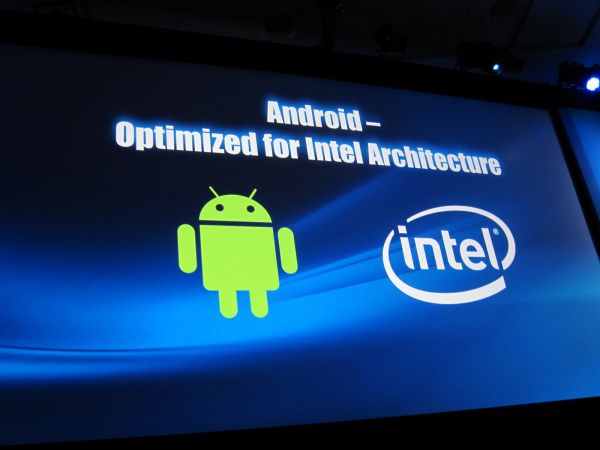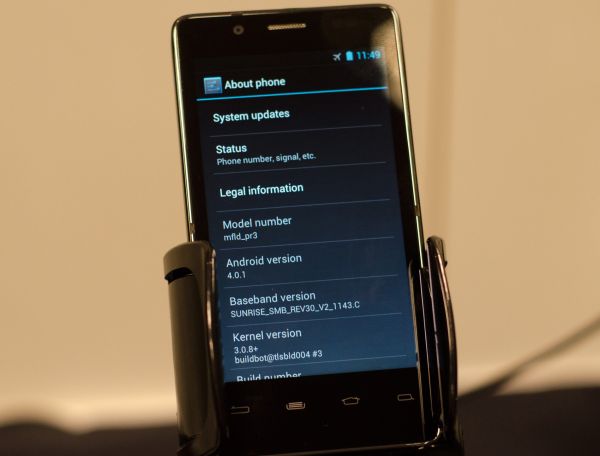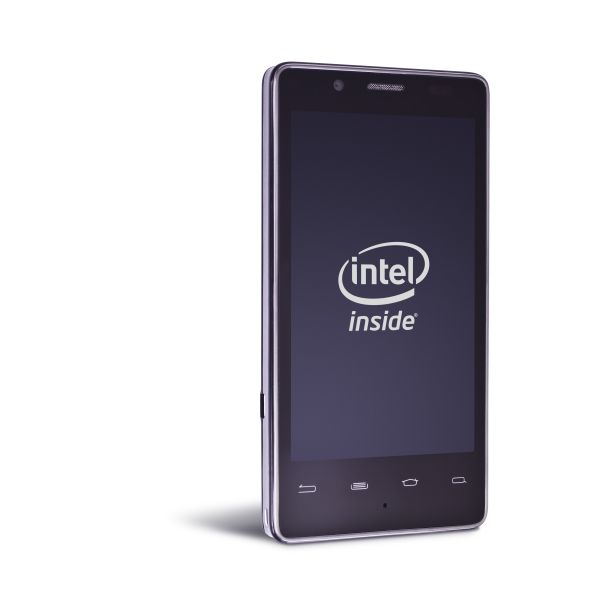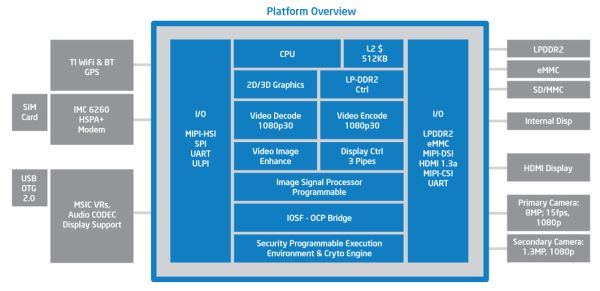Intel's Medfield & Atom Z2460 Arrive for Smartphones: It's Finally Here
by Anand Lal Shimpi on January 10, 2012 8:00 PM ESTWhat's Different This Time Around: Google & A Sweet Reference Platform
Intel has been talking about getting into smartphones for a couple of years now, but thus far it hasn't been able to secure a single design or partnership that that resulted in a product actually coming to market. This time around, things are different. The major change? Focus, and Google.
Intel originally had ambitions of enabling its own mobile OS with the help of Nokia (Moblin/MeeGo). Intel also wanted to support Android as well, however its attention was clearly more focused on the Moblin/MeeGo effort. Similar to the wake up call that pushed NVIDIA to focus exclusively on Android, Intel has now done the same.
At IDF last year Intel and Google announced a partnership and the intention to bring all future versions of Android, starting with Gingerbread, to x86. Since then Intel has ramped up the software engineering engine, going into the Android source code (Gingerbread, Honeycomb and now ICS) and fixing bugs. Intel's goal is to deliver the most stable version of Android as a result of its efforts. Intel is also submitting its changes upstream to the AOSP, which should help improve the Android experience even on ARM platforms.
Under the leadership of Mike Bell (formerly of Apple and Palm), Intel has also created an extremely polished Medfield reference design. This is the same design shown off at IDF last year (apparently there's an even thinner one floating around somewhere), but what separates it from other reference designs we've seen from SoC vendors is that the Medfield reference platform was designed to be a polished phone that could theoretically be rebranded and resold.
Intel knew the onus was on itself to prove that Medfield, Atom and even just x86 was power efficient enough to be delivered in a compelling form factor with competitive battery life. Paul Otellini gave Mike carte blanche access to any of Intel's resources. Instead of having to work with existing Intel groups, Mike was allowed to assemble his dream team of engineers. The team Mike built is what he felt he needed to not only bring Medfield to market, but also to build the a first class Atom based smartphone.
The result is this:
Internally it features Intel's own XMM 6260 HSPA+ modem. Intel claims LTE is on the way although there's no ETA on that.
WiFi in the reference design is provided by TI's 1283 controller. Intel's wireless team does not have a a WiFi solution that's low power enough to work in a smartphone, although after the recent restructuring the team has now been tasked with building an ultra low power solution that can.
The display is a somewhat unusual 1024 x 600 panel, with support for 1080p30 (and 1080i60) output via HDMI. The SoC specs are identical to what I've already discussed: 1.6GHz max CPU clock and a 400MHz GPU clock.
The reference platform is not only smartphone sized, but Intel has built its own qualification labs that mirror those of the carriers to ensure quality and convince its customers of the platform's legitimacy. In essence, Intel has built its own miniature smartphone design and test center.
The Medfield reference platform is available for use by any of Intel's customers, and indeed that's what's already happening. Lenovo's K800 is based on a modified version of Intel's reference platform, and I wouldn't be surprised if more aren't on the way.
All of this sounds a lot like Intel's efforts in the motherboard space over a decade ago where it started providing motherboard manufacturers with reference designs that they could modify if they desired. The effort helped significantly reduce time to market and allowed the motherboard makers to focus more on specializing on what they were good at.
The Medfield reference platform is designed to do the very same for smartphones. Intel wants to provide its partners with a well designed, stable smartphone platform. If they choose to use it, they can shave off a significant amount of development time and spend more of their time on software or simply bring a good reference phone to market in a quick fashion. I'm not entirely sure I've seen many players in the Android space that are actually all that great at software development, but Intel believes anything that shortens time to market will be appreciated.
I asked Intel if it has any plans to offer the reference platform unlocked, direct to customers. Unfortunately the answer at this point is still no. I suspect that Intel is more interested in building its customer base rather than circumventing it.
















164 Comments
View All Comments
Penti - Wednesday, January 11, 2012 - link
And it doesn't matter since the SoC's or rather CPU's aimed at Windows x86/64 tablets and Windows appliances does have SGX545. Windows 8 and Windows Phone (CE based) are two totally different OS's any way and Windows Phone is having a hard time just to support Qualcomm Snapdragon S1 and S2. I don't want to run Windows 8 Ribbon/MFC/WPF software on a phone platform neither do you. Microsoft won't support Windows Phone on x86. Microsoft won't support Windows 8 on this.They will as in Microsoft on Cedar Trail-M if PowerVR and Intel which have to ship them ever get their poor Windows drivers working. PowerVR/ImgTec aren't known for their Windows driver quality.
In a tablet and even tablet-PC (which Microsoft is still going for) it's mostly the screen that uses power. It doesn't matter if the cpu and chipset uses the 5W TDP plus 2.1W TDP it's still more power efficient then anything else running Windows (NT). It's just a few watts and a screen that will use just as much if not more power. In a phone on the other hand you can't have massive batteries and screens.
Intel is aiming the SoC towards Android handsets and tablets i.e. pads not tablet-pcs. They don't list DX support or even Windows Embedded support. Neither does it support more then 1GB of ram. It's built to interface with modem (baseband), LPDDR2, HDMI, MIPI-DSI, USB Phy, eMMC, with camera modules not with ordinary PC hardware topology of DDR3, PCI-e, LVDS/eDP, South bridge chipsets containing basic I/O. As well as support for USB, ethernet, SATA and whatnot in the SB. Memory will come included in the package too. Simply another platform.
Not for powering Office 2010 and Visual Studio 2012. Look for other chips there.
MySchizoBuddy - Tuesday, January 10, 2012 - link
This would be very interesting if it is launched TODAY not end of year.tipoo - Tuesday, January 10, 2012 - link
Yeah, that's why I'm wondering how it will perform against chips its actually going to compete with, namely Cortex A15 designs. The gap here is pretty big, but not insurmountable I think, and the A15 looks promising as well.tipoo - Tuesday, January 10, 2012 - link
Colour me impressed! This looks like it will be a rather disruptive SoC, especially with ARM Binary Translation. The nice thing is its a single core so developers don't have to optimize for two or four cores to get maximum performance. Although, I wonder if something like the quad core Tegra 3 would be able to best its performance if everything was more optimized for multicore? And more importantly, how will it fare against Cortex A15 designs. But, yeah, I'm excited for this, even more so for the variant with the 543MP2.Morg. - Thursday, January 12, 2012 - link
ARM binary translation will be slow ... like real slow.It's like a VM but on a different arch.
The tegra3 is just slightly slower .. on 40nm
Against A9 on the same process, ARM wins, against A15 ARM butchers.. nothing really different in the end - just that Intel can only count on process advantage to keep more or less in the race (so far).
milli - Tuesday, January 10, 2012 - link
Jason, yes I'm talking to you Jason Mick: oh how much you look like a fool now. Many people (including me) tried to warn you about your wrong article.DigitalFreak - Tuesday, January 10, 2012 - link
Wrong site, foo.Iketh - Tuesday, January 10, 2012 - link
I was thinking about that the entire time I was reading this.bji - Thursday, January 12, 2012 - link
What are you guys talking about?mikeepu - Thursday, January 12, 2012 - link
At first i thought the same thing as DigitalFreak, but i thought about it and went back to Jason Mick's article last month http://tinyurl.com/JasonMicksMedfieldArticle and found your comment. Yes. Yes, you did.